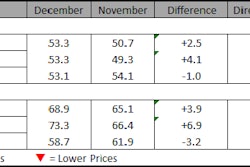
Construction costs rose for the first time since December 2014, according to IHS Markit and the Procurement Executives Group (PEG). The headline current IHS PEG Engineering and Construction Cost Index registered 50.7 in November, up from 48.7 in October. Strength was evident in labor markets, though not in materials or equipment prices, which continued to see pockets of weakness.
The current materials/equipment price index came in at 49.3 in November, its second consecutive monthly reading below 50. Six of 12 categories tracked in the materials sub-index showed falling prices, three had rising prices and three remained unchanged. Price increases in copper-based wire and cable as well as steel continued to filter down to final demand categories such as transformers and electrical equipment. However, weakness persists in exchangers, pumps and turbines.
"October's employment report confirmed what anecdotal evidence has pointed to for some time: the construction labor market is experiencing shortages and the tightening labor market is finally resulting in stronger wage growth,” said Emily Crowley, senior economist at IHS Pricing and Purchasing. “Average hourly earnings for construction workers rose 4.0 percent year-over-year in the third quarter, the strongest wage growth the sector has seen in seven years. The industry unemployment rate is tracing record lows with the number of job vacancies is on the rise, indicating firms are having trouble filling positions. Improving nonresidential proposal activity will keep pressure on construction labor demand, and consequently, labor costs.”
After six months of soft figures, the current subcontractor labor index rose to 54.1 in November. Regionally across the United States, subcontractor labor costs were mixed. In the Northeast and West, labor costs rose; costs were flat in the Midwest and South. Even areas affected by the downturn in energy markets are feeling the effects of tightening labor market. Similarly in Canada, labor costs rose in the Eastern regions, but they remained soft in the West.
The six-month headline expectations index recorded increasing prices. The index moved up further from 55.4 in October to a strong 65.1 in November. The materials/equipment index rose from 56.5 to 66.4 this month, affirming widespread expectations of higher future prices. Every component showed rising prices; there were no expectations for softer materials prices.
Similar to the materials index, sub-contractor labor price expectations came in higher in November. The sub-index moved up from 53.0 this month to 61.9; labor costs are expected to rise in every region.
In the survey comments, respondents have noted no shortages in supply of materials. Proposal activity has registered an uptick in recent months, and participants are showing some optimism for 2017.

















